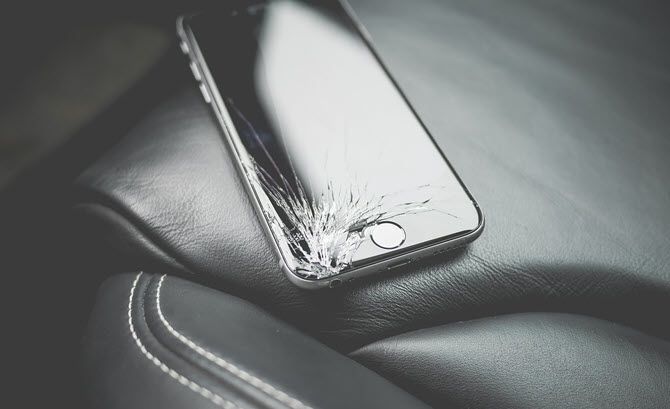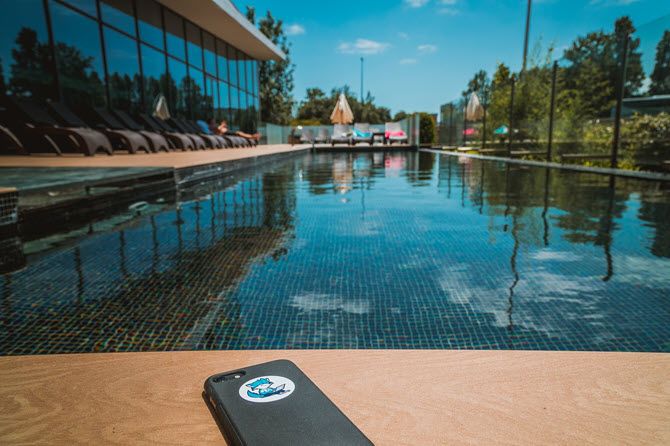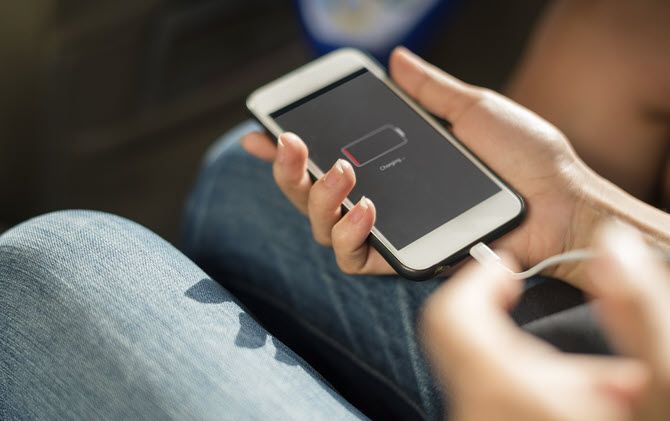By Ryan Dube
Yes, that little smartphone you keep in your pocket has the potential to burst—and it’s not limited to exploding Samsung batteries. A lithium-ion battery is the same no matter what device it’s in, and they all carry identical risks.
What are these risks? And how can you reduce them with your phone? That’s what we’re going to explore in this article.
Smartphone Battery Explosions: The Facts
We don’t have a bunch of doom-and-gloom fear-mongering stories for you. Yes, your phone can explode. But no, it’s isn’t likely to happen at all.
Modern lithium-ion batteries—today’s preferred rechargeable batteries for everything from smartphones to Tesla vehicles—have the capacity to be highly explosive.
Have a look at this thermal video of a lithium-ion battery cell under “heat abuse” for two minutes:
The point of explosion is sudden and extremely hot.
But outside of a lab where people apply an extremely hot source to the battery, how do these batteries explode in the real world?
Here is the sequence of events that happen inside a lithium-ion battery before and during an explosion:
- One area of the battery starts getting too hot due to a short-circuit in the charging circuit, or some other external cause.
- The chemical reaction inside the hot area begins generating its own heat as well, which spreads to other areas in a process known as electrolyte overheat.
- Eventually, this building heat causes the electrolyte to give off stream, which bursts the battery casing.
- Very flammable, hot liquid (not unlike napalm) escapes and usually burns or melts the surrounding phone casing and whatever the phone is next to.
This reaction, known as “thermal runaway,” does sound pretty horrendous, but there’s one fact that should set your mind at ease: manufacturers are constantly implementing new safety features in lithium-ion batteries that reduce the likelihood of this happening, or at least reduce the damage caused when it does.
Smartphone Battery Safety Features
Some of these safety features include:
- Non-flammable additives added to the electrolyte and battery coatings.
- Built-in circuitry that protects against current surges.
- Circuit interrupt devices that open the circuit if the cell pressure exceeds safe limits.
- Fail-safe safety vents that release gases if the cell expands beyond a higher safety limit.
- Thermal fuses that break the circuit when temperatures reach a safety limit.
So for a healthy battery installed inside the average phone, the worse-case scenario before the battery ever reaches this nightmare “thermal runaway” scenario is a message that the phone needs to shut down. Or the battery may simply stop working.
Still, there are situations that could still cause a battery to explode.
1. Dropping and Damaging the Battery
As mentioned above, everything will work fine so long as you are dealing with a healthy battery. One problem that can negatively affect a battery’s health is physical damage from drops.

Most people will rush to a local repair center to get their screen repaired when this happens. If the phone still works, they don’t even give a second thought to what damage the battery might have sustained.
Unfortunately, a drop can alter the internal mechanical or chemical structure of the battery. These changes could cause any of the fail-safe circuitry to fail in extreme stress conditions.
How can you tell if a battery might be damaged? Open up the case and take a look at the battery. If any of the following conditions exist, consider replacing it immediately:
- Swelling
- Deformation
- Frequent, unexplainable overheating
In many situations, you can avoid explosive battery failure by paying close attention to signs of existing battery damage. For a smartphone battery to be safe, all its built-in safety features need to function properly. So it’s important to never use a battery that has visible signs of damage.
2. Hot Temperatures and Environments
While there may be safeguards built into your battery to ensure that it sheds excessive heat, or shuts down when too hot, it’s important to keep the battery away from those temperature limits in the first place.
Many elements contribute to your phone naturally heating up. Those include:
- Running intensive graphics that put a heavy load on the GPU
- Using apps that put too much demand on the CPU
- Widgets that run constantly while you’re multitasking with the phone
- Regularly connectivity checks when your cellular or Wi-Fi connection is spotty
- Long phone calls
Normally any of these uses are fine, but if you’re doing them in an environment that’s extra hot, you could run into trouble. For example, using a phone in direct sunlight at the pool, while listening to Spotify and browsing the web, makes an already straining smartphone struggle to cool itself.

Even if this doesn’t cause the battery to explode, it can contribute to the aging process and make getting long battery life a challenge.
5 Advanced Ways to Improve Battery Life on AndroidIf you've got a rooted Android device (or you're willing to root it), and you want better battery life, we can help you out.READ MORE
Charging your phone under these conditions can contribute to overheating even further. The phone naturally builds heat during charging.
There are many ways to keep your phone cool and avoid these problems:
- Remove the phone from its case when you’re charging it.
- Keep the phone out of direct sunlight whenever possible.
- Don’t leave your phone in a hot car for extended periods.
- Don’t charge the phone while it’s in a pocket or inside a bag, or any other place that can trap heat.
We’ve offered many ways to avoid overheating an Android phone, and tips to keep your iPhone cool. Following these is an important part of being a wise smartphone user.
How to Prevent Your Android Phone from OverheatingIf you've ever had your Android phone get way too hot, we have some solutions you could try out.READ MORE3. Using the Wrong Charger
I purchased a first-generation Google Pixel when it launched. Not knowing that the Pixel requires a cable with a built-in 56k Ohm resistor conforming to Type C specifications, I grabbed a cheap cable in the checkout line at Walmart to charge it.
How to Buy a USB-C Cable That Won't Destroy Your DevicesA few months ago, Amazon banned USB-C cables that did not meet the standards set forth by the USB Implementers Forum (USB-IF), and for good reason: such cables are prone to failure, can damage connected...READ MORE
I incorrectly assumed all USB-C cables are manufactured the same. The reality is that manufacturers of cheap chargers produce cables that do not always meet specifications required by USB-C devices.
After some time using it, I started noticing my phone became especially hot during charging.

One day when I went to charge my phone in my car, the phone became extremely hot and the charger actually became stuck in the charger port. As I was trying to pull it out, a small puff of smoke came out of the charger port.
I’m lucky I didn’t experience a smartphone exploding in my face.
Thankfully, Verizon replaced the phone under the manufacturer’s warranty. But the lesson I learned was an important one: Buy brand-name chargers from reputable retailers!
You can buy non-OEM chargers, but you need to make sure they meet all specifications required by your phone. Cheap knockoff chargers like these use materials with sub-standard quality or an incorrect gauge of wire that lacks appropriate overcurrent protection.
If you don’t invest in a quality charger, you can run into charging problems at best. At worst, you’re risking not only the destruction of your expensive phone, but possible injury to yourself.
5 Reasons Why Your Phone Is Charging SlowlyWondering why your phone won't charge as fast as it used to? Here are a few possible causes that could explain why.READ MORE4. Getting Your Phone Wet
Lithium will ignite and burn when in contact with water or water vapor. Batteries come well-sealed, so that kind of contact shouldn’t happen normally.
Many modern phones are waterproof or water-resistant. However, combine a cheap smartphone with a punctured battery, and you’ve got a recipe for disaster.
What Makes a Device Waterproof or Water-Resistant?A lot of devices are marketed as waterproof, but that can be severely misleading. Most are actually water-resistant. What's the difference? Here's everything you need to know about it.READ MORE5. Battery Punctures
Lithium reacts to both water and oxygen, so puncturing a lithium-ion battery will produce a reaction. This could be anything from a little bit of smoke and a terrible smell to a full-on explosion.
And the reaction is rapid.
Obviously, this means there’s always a danger if a smartphone gets punctured during an accident or any other violent situation.
Staying Safe With Smartphone Batteries
It’s important to keep in mind that the battery inside your smartphone has the capacity to become a dangerous hazard under extreme conditions.
So the idea is to avoid those extreme conditions. Store, charge, and treat your smartphone in a way so that should anything ever happen, you are protected from serious injury.
To learn more, check out some common misconceptions about smartphone batteries.
8 Common Misconceptions About Mobile Device Batteries You Need To KnowLet's strap in and clear the air about some of these commonly-held mobile battery myths.READ MORE
Image Credit: weerapat/Depositphotos Credit: www.makeuseof.com
2 comments:
The battery inside our smartphone has the capacity to become a dangerous hazard under extreme conditions. Appreciate your sharing is very informative for everyone to protected themselves from serious injuries and damages.
November Printable Calendar
Get the Fastest VPN for 2018 that allows you to access blocked and restricted content from anywhere in the world. Stream and Download with complete anonymity and security. FastestVPN service provider offers secure access and high speed. https://bit.ly/2KqVxG4
Post a Comment